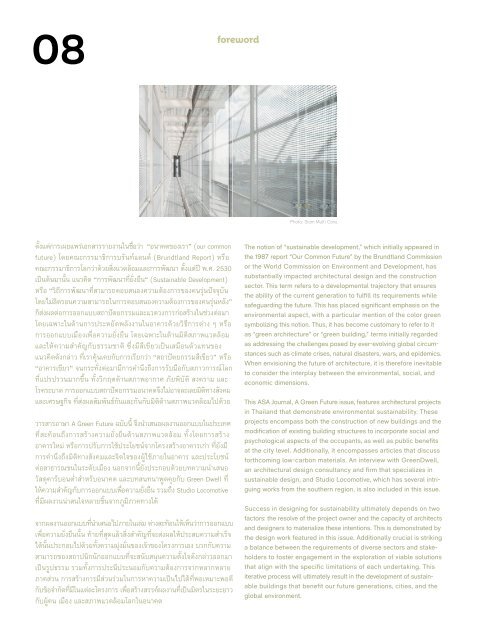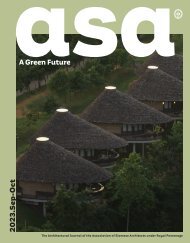ASA Journal 15/2023
You also want an ePaper? Increase the reach of your titles
YUMPU automatically turns print PDFs into web optimized ePapers that Google loves.
08<br />
foreword<br />
Photo: Siam Multi Cons<br />
ตั้งแต่การเผยแพร่เอกสารรายงานในชื่อว่า “อนาคตของเรา” (our common<br />
future) โดยคณะกรรมาธิการบรันท์แลนด์ (Brundtland Report) หรือ<br />
คณะกรรมาธิการโลกว่าด้วยสิ่งแวดล้อมและการพัฒนา ตั้งแต่ปี พ.ศ. 2530<br />
เป็นต้นมานั้น แนวคิด “การพัฒนาที่ยั่งยืน“ (Sustainable Development)<br />
หรือ “วิถีการพัฒนาที่สามารถตอบสนองความต้องการของคนรุ่นปัจจุบัน<br />
โดยไม่ลิดรอนความสามารถในการตอบสนองความต้องการของคนรุ่นหลัง”<br />
ก็ส่งผลต่อการออกแบบสถาปัตยกรรมและแวดวงการก่อสร้างในช่วงต่อมา<br />
โดยเฉพาะในด้านการประหยัดพลังงานในอาคารด้วยวิธีการต่าง ๆ หรือ<br />
การออกแบบเมืองเพื่อความยั่งยืน โดยเฉพาะในด้านมิติสภาพแวดล้อม<br />
และให้ความสำาคัญกับธรรมชาติ ซึ่งมีสีเขียวเป็นเสมือนตัวแทนของ<br />
แนวคิดดังกล่าว ที่เราคุ้นเคยกับการเรียกว่า “สถาปัตยกรรมสีเขียว” หรือ<br />
“อาคารเขียว” จนกระทั่งต่อมามีการคำานึงถึงการรับมือกับสภาวการณ์โลก<br />
ที่แปรปรวนมากขึ้น ทั้งวิกฤตด้านสภาพอากาศ ภัยพิบัติ สงคราม และ<br />
โรคระบาด การออกแบบสถาปัตยกรรมอนาคตจึงไม่อาจละเลยมิติทางสังคม<br />
และเศรษฐกิจ ที่ส่งผลสัมพันธ์กันและกันกับมิติด้านสภาพแวดล้อมไปด้วย<br />
วารสารอาษา A Green Future ฉบับนี้ จึงนำาเสนอผลงานออกแบบในประเทศ<br />
ที่สะท้อนถึงการสร้างความยั่งยืนด้านสภาพแวดล้อม ทั้งโดยการสร้าง<br />
อาคารใหม่ หรือการปรับการใช้ประโยชน์จากโครงสร้างอาคารเก่า ที่ยังมี<br />
การคำานึงถึงมิติทางสังคมและจิตใจของผู้ใช้ภายในอาคาร และประโยชน์<br />
ต่อสาธารณชนในระดับเมือง นอกจากนี้ยังประกอบด้วยบทความนำาเสนอ<br />
วัสดุคาร์บอนต่ำาสำาหรับอนาคต และบทสนทนาพูดคุยกับ Green Dwell ที่<br />
ให้ความสำาคัญกับการออกแบบเพื่อความยั่งยืน รวมถึง Studio Locomotive<br />
ที่มีผลงานน่าสนใจหลายชิ้นจากภูมิภาคทางใต้<br />
จากผลงานออกแบบที่นำาเสนอไปภายในเล่ม ต่างสะท้อนให้เห็นว่าการออกแบบ<br />
เพื่อความยั่งยืนนั้น ท้ายที่สุดแล้วสิ่งสำาคัญที่จะส่งผลให้ประสบความสำาเร็จ<br />
ได้นั้นประกอบไปด้วยทั้งความมุ่งมั่นของเจ้าของโครงการเอง บวกกับความ<br />
สามารถของสถาปนิกนักออกแบบที่จะสนับสนุนความตั้งใจดังกล่าวออกมา<br />
เป็นรูปธรรม รวมทั้งการประนีประนอมกับความต้องการจากหลากหลาย<br />
ภาคส่วน การสร้างการมีส่วนร่วมในการหาความเป็นไปได้ที่พอเหมาะพอดี<br />
กับข้อจำากัดที่มีในแต่ละโครงการ เพื่อสร้างสรรค์ผลงานที่เป็นมิตรในระยะยาว<br />
กับผู้คน เมือง และสภาพแวดล้อมโลกในอนาคต<br />
The notion of “sustainable development,” which initially appeared in<br />
the 1987 report “Our Common Future” by the Brundtland Commission<br />
or the World Commission on Environment and Development, has<br />
substantially impacted architectural design and the construction<br />
sector. This term refers to a developmental trajectory that ensures<br />
the ability of the current generation to fulfill its requirements while<br />
safeguarding the future. This has placed significant emphasis on the<br />
environmental aspect, with a particular mention of the color green<br />
symbolizing this notion. Thus, it has become customary to refer to it<br />
as “green architecture” or “green building,” terms initially regarded<br />
as addressing the challenges posed by ever-evolving global circumstances<br />
such as climate crises, natural disasters, wars, and epidemics.<br />
When envisioning the future of architecture, it is therefore inevitable<br />
to consider the interplay between the environmental, social, and<br />
economic dimensions.<br />
This <strong>ASA</strong> <strong>Journal</strong>, A Green Future issue, features architectural projects<br />
in Thailand that demonstrate environmental sustainability. These<br />
projects encompass both the construction of new buildings and the<br />
modification of existing building structures to incorporate social and<br />
psychological aspects of the occupants, as well as public benefits<br />
at the city level. Additionally, it encompasses articles that discuss<br />
forthcoming low-carbon materials. An interview with GreenDwell,<br />
an architectural design consultancy and firm that specializes in<br />
sustainable design, and Studio Locomotive, which has several intriguing<br />
works from the southern region, is also included in this issue.<br />
Success in designing for sustainability ultimately depends on two<br />
factors: the resolve of the project owner and the capacity of architects<br />
and designers to materialize these intentions. This is demonstrated by<br />
the design work featured in this issue. Additionally crucial is striking<br />
a balance between the requirements of diverse sectors and stakeholders<br />
to foster engagement in the exploration of viable solutions<br />
that align with the specific limitations of each undertaking. This<br />
iterative process will ultimately result in the development of sustainable<br />
buildings that benefit our future generations, cities, and the<br />
global environment.

















